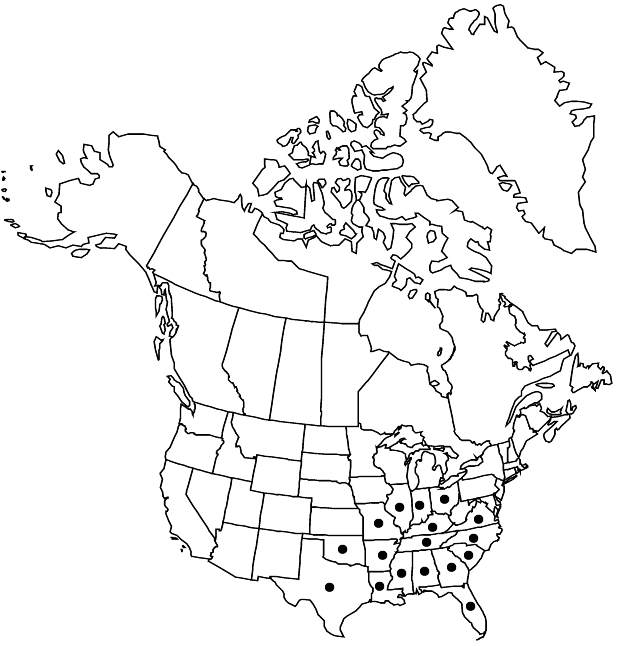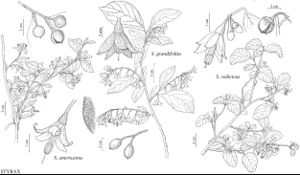Styrax americanus
in J. Lamarck et al., Encycl. 1: 82. 1783 (as americana) ,.
Shrubs or trees, to 5 m, not suckering from roots. Leaves: petiole 2–6 mm; blade with 5–8 secondary-veins, elliptic or broadly elliptic to obovate or nearly ovate, 1.2–10 × 0.6–5.7 cm, largest blades on sterile shoots 2–5.7 cm wide, margins of at least some leaves denticulate to serrate, rarely also lobed, longest arms of abaxial hairs 0.1–0.2 mm. False-terminal inflorescences 2–5-flowered or solitary flower, 2–3.5 cm; axillary flowers present on at least some shoots (subtending leaves often reduced). Pedicels 4–10 (–14) mm, longer than calyx. Flowers: calyx 2.5–4 × 2.5–4.5 mm; corolla 11–16 mm, tube 1.5–3 mm, lobes 5 (–6), imbricate or subinduplicate-valvate in bud, strongly reflexed, elliptic to narrowly elliptic, 7–14 × 1–5 mm; filaments distinct beyond adnation to corolla. Capsules globose, 7–9 × 7–9 mm (broader when 2–3-seeded), gray stellate-pubescent, dehiscent nearly or completely to proximal end, broadly exposing seed (s); fruit wall 0.3–0.4 mm thick. 2n = 16.
Phenology: Flowering Mar–Jun; fruiting Jun–Oct.
Habitat: Wooded floodplains, swamps, boggy slopes, hammocks, usually in sandy or peaty soils
Elevation: 0-300 m
Distribution

Ala., Ark., Fla., Ga., Ill., Ind., Ky., La., Miss., Mo., N.C., Ohio, Okla., S.C., Tenn., Tex., Va.
Discussion
Styrax grandifolius is partly sympatric with S. americanus, and molecular data indicate that it is a close relative (P. W. Fritsch 2001). The two species are separated ecologically, with S. americanus occupying lower, moister sites (G. J. Gonsoulin 1974). Hybridization between the two is not apparent.
Some authors have recognized plants with more densely pubescent new shoots, leaves, and inflorescences and shorter pedicels as a distinct taxon, at either the specific or infraspecific level (J. K. Small 1933; A. J. Rehder 1940; G. J. Gonsoulin 1974). The most densely pubescent plants occur in the southernmost portion of the range of the species; intermediates between the two extremes are abundant. The character differences that separate the taxa are here considered taxonomically inconsequential.
Selected References
None.
Lower Taxa
"lengthofcorolla" is not declared as a valid unit of measurement for this property.
